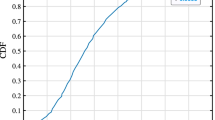Abstract
The next generation broadband access networks must provide high speed bidirectional data channels and support more concurrent subscribers than ever before. While mega-bits-per-second data rates have been demonstrated for the downlink channels, progress on uplink has been slow. We propose a hybrid architecture for CDMA uplink that seamlessly integrates short-range radio and WCDMA interfaces in the same network. In our scheme, mobile stations (subscribers) can operate as Relaying Mobile Terminal (RMT) to relay uplink traffic for nearby mobile stations. Our analysis and simulations show that the deployment of RMTs significantly reduces the radio transmissions in the CDMA uplink. Moreover, the scheme results in a much lower out-of-cell interference to the neighboring network cells. The problem of finding the optimum RMT set turns out to be NP-hard. Several heuristics are evaluated in terms of RMT size and out-of-cell interference. In particular, we investigated a novel vertex cover based heuristic algorithm. Our method uses mobile pilot signals and mobile location to estimate a interference function for each node. This function is then used in selecting a maximum matching for the candidate RMT set. Simulation results are somewhat surprising: the simple greedy algorithm has very close performance to that of the optimum algorithm when only the RMT size is concerned. When out-of-cell interference is considered, the proposed algorithm outperforms both greedy and 2-approximation algorithm.










Similar content being viewed by others
Notes
Typical cell radius in a 3G network is 2 miles, which is about 30 times of the 100-m effective range for a typical WLAN.
The pilot channel is transmitted in low power, and uses only a small portion of a slot time to minimize the interference.
Total number of mobiles in the 120°-fan area of the cell sector.
In fact, ln(|V|) is a tight upper bound.
References
Aggelou, G. N., & Tafazolli, R. (2001). On the relaying capacity of next-generation GSM cellular networks. IEEE Personal Communications Magazine, 8(1), 40–47.
Bar-Yehuda, R., & Even, S. (1985). A local ratio theorem for approximating the weighted vertex cover problem. Annals of Discrete Mathematics, 25, 27–45.
Chvatal, V. (1979). A greedy heuristic for the set covering problem. Mathematics of Operations Research, 4, 233–235.
Cormen, T., Leiserson, C., & Rivest, R. (1990). Introduction to algorithms. Cambridge MA: MIT Press.
Dai, F., & Wu, J. (2004). An extended localized algorithm for connected dominating set formation in ad hoc wireless networks. IEEE Transactions on Parallel and Distributed Systems, 15(10), 908–920.
Guha, S., & Khuller, S. (1998). Approximation algorithms for connected dominating sets. Algorithmica, 20(4), 374–387.
Luo, H., Ramjee, R., Sinha, P., Li, L., & Lu, S. (2003). UCAN: A unified cellular and ad-hoc network architecture. In Proceedings of ACM Mobicom’03. Sep 2003.
Marathe, M. V., Breu, H., Hunt, H. B. III, Ravi, S. S., & Rosenkrantz, D. J. (1995). Simple heuristics for unit disk graphs. Networks, 25, 59–68.
Nemhauser, G. L., & Trotter, L. E. (1975). Vertex packings: Structural properties and algorithms. Mathematical Programming, 8, 232–248.
Paschos, V. T. (1997). A survey of approximately optimal solutions to some covering and packing problems. ACM Computing Surveys, 29(2), 171–209.
Qayyum, A., Viennot, L., & Laouiti, A. (2002). Multipoint relaying for flooding broadcast messages in mobile wireless networks. In Proceedings of the Hawaii International Conference on System Sciences (HICSS’02). January 2002.
Viterbi, A. J., Viterbi, A. M., et al. (1994). Soft Handoff extends CDMA cell coverage and increases reverse link capacity. IEEE Journal on Selected Areas in Communications, 12, 1281–1288.
Wu, H., Qiao, C., De, S., & Tonguz, O. (2001). An integrated cellular and ad hoc relaying system: iCAR. IEEE Journal on Selected Areas in Communications, 19(10), 2105–2115.
Wu, J. (2002). Extended dominating-set-based routing in ad hoc wireless networks with unidirectional links. IEEE Transactions on Parallel and Distributed Systems, 13(9), 866–881.
Wu, X., Chan, S.-H., & Mukherjee, B. (2000). MADF: A novel approach to add an ad-hoc overlay on a fixed cellular infrastructure. In Proceedings of IEEE WCNC (Vol. 2, pp. 549–554).
Author information
Authors and Affiliations
Corresponding author
Rights and permissions
About this article
Cite this article
Wang, J., Liu, J.C.L. Uplink relaying in hybrid wireless networks with out-of-cell interference reduction. Wireless Netw 15, 1113–1125 (2009). https://doi.org/10.1007/s11276-008-0106-5
Published:
Issue Date:
DOI: https://doi.org/10.1007/s11276-008-0106-5




